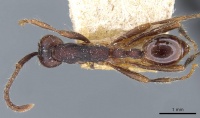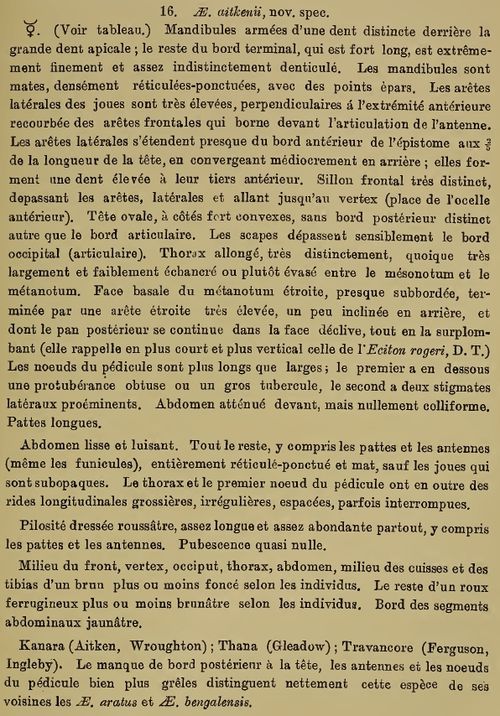Aenictus aitkenii
| Aenictus aitkenii | |
|---|---|

| |
| Scientific classification | |
| Kingdom: | Animalia |
| Phylum: | Arthropoda |
| Class: | Insecta |
| Order: | Hymenoptera |
| Family: | Formicidae |
| Subfamily: | Dorylinae |
| Genus: | Aenictus |
| Species: | A. aitkenii |
| Binomial name | |
| Aenictus aitkenii Forel, 1901 | |
| Synonyms | |
| |
This species is known from India and Sri Lanka.
Identification
A member of the pachycerus group. This species is similar to A. aratus (with which it has been treated as a junior synonym) and A. nesiotis but differs in having a broader head (cephalic index > 87 versus CI < 88 in A. nesiotis), and broader and more bulbous petiole and postpetiole (both are narrower in A. aratus and A. nesiotis). The scape is also relatively longer than in the others (scape index > 115 versus < 115). It is similar to A. levior in the shape of the head but differs in having longer scapes (Shattuck, 2008).
Keys including this Species
Distribution
Latitudinal Distribution Pattern
Latitudinal Range: 32.628611° to 12.54305556°.
| North Temperate |
North Subtropical |
Tropical | South Subtropical |
South Temperate |
- Source: AntMaps
Distribution based on Regional Taxon Lists
Oriental Region: India (type locality), Sri Lanka.
Distribution based on AntMaps
Distribution based on AntWeb specimens
Check data from AntWeb
Countries Occupied
| Number of countries occupied by this species based on AntWiki Regional Taxon Lists. In general, fewer countries occupied indicates a narrower range, while more countries indicates a more widespread species. |

|
Estimated Abundance
| Relative abundance based on number of AntMaps records per species (this species within the purple bar). Fewer records (to the left) indicates a less abundant/encountered species while more records (to the right) indicates more abundant/encountered species. |

|
Biology
Castes
Known only from the worker caste.
Nomenclature
The following information is derived from Barry Bolton's Online Catalogue of the Ants of the World.
- aitkenii. Aenictus aitkenii Forel, 1901a: 475 (w.) INDIA (Karnataka, Kerala).
- Type-material: syntype workers (number not stated).
- Type-localities: India: Kanara (E.H. Aitken), India: Kanara (R.C. Wroughton), India: Thana (Gleadow), India: Travancore (Ferguson), India: Travancore (Ingleby).
- Type-depository: MHNG.
- [Aenictus aitkenii Forel, 1900b: 75 (in text). Nomen nudum.]
- Junior synonym of aratus: Wilson, 1964a: 446; Bolton, 1995b: 58; Tiwari, 1999: 17.
- Status as species: Bingham, 1903: 19; Emery, 1910b: 29; Wheeler, W.M. 1919e: 62; Chapman & Capco, 1951: 10; Shattuck, 2008c: 16; Bharti, Wachkoo & Kumar, 2012: 294 (in key); Bharti, Guénard, et al. 2016: 20; Dias, R.K.S. et al. 2020: 22.
- Senior synonym of asiatica: Shattuck, 2008c: 16.
- Distribution: India, Sri Lanka.
- asiatica. Aenictus aratus var. asiatica Forel, 1911h: 453 (w.) SRI LANKA.
- Type-material: syntype workers (number not stated).
- Type-locality: Sri Lanka (“Ceylon”): (no further data) (E.E. Green).
- Type-depository: MHNG.
- Subspecies of aratus: Chapman & Capco, 1951: 10.
- Junior synonym of aratus: Wilson, 1964a: 446; Bolton, 1995b: 58.
- Junior synonym of aitkenii: Shattuck, 2008c: 16.
Unless otherwise noted the text for the remainder of this section is reported from the publication that includes the original description.
Description
Type Material
- asiatica. Aenictus aratus var. asiatica Forel, 1911h: 453 (w.) SRI LANKA. Junior synonym of aratus: Wilson, 1964a: 446; of aitkenii: Shattuck, 2008c: 16.
- Aenictus aitkenii: Worker syntypes from Kanara, Thana and Travancore, India.
- Aenictus aratus var. asiatica: Worker syntype from Sri Lanka.
References
- Basu, P. 1997. Seasonal and spatial patterns in ground foraging ants in a rain forest in the Western Ghats, India. Biotropica 29: 489-500.
- Forel, A. 1901a. Les Formicides de l'Empire des Indes et de Ceylan. Part VIII. The Journal of the Bombay Natural History Society. 13:462-477. (page 475, worker described)
- Sahoo, B., Ramakrishnaiah, S., Rajan, P.D., Datta-Roy, A. 2023. A new species of army ant genus Aenictus (Hymenoptera: Formicidae) from India. Journal of the Entomological Research Society 25(3), 615-622 (doi:10.51963/jers.v25i3.2504).
- Shattuck, S.O. 2008c. Review of the ant genus Aenictus in Australia with notes on A. ceylonicus (Mayr). Zootaxa. 1926:1-19.
- Wilson, E. O. 1964a. The true army ants of the Indo-Australian area (Hymenoptera: Formicidae: Dorylinae). Pacific Insects. 6:427-483. (page 446, junior synonym of aratus)
References based on Global Ant Biodiversity Informatics
- Baroni Urbani C. 1977. Katalog der Typen von Formicidae (Hymenoptera) der Sammlung des Naturhistorischen Museums Basel (2. Teil). Mitt. Entomol. Ges. Basel (n.s.) 27: 61-102.
- Basu P. 1994. Ecology of ground foraging ants in a tropical evergreen forest in Western Ghats, India. PhD Thesis, School of ecology and environmental sciences, Pondichery University, India. 155 pages.
- Bharti H., Y. P. Sharma, M. Bharti, and M. Pfeiffer. 2013. Ant species richness, endemicity and functional groups, along an elevational gradient in the Himalayas. Asian Myrmecology 5: 79-101.
- Chapman, J. W., and Capco, S. R. 1951. Check list of the ants (Hymenoptera: Formicidae) of Asia. Monogr. Inst. Sci. Technol. Manila 1: 1-327
- Chapman, J.W. and S.R. Capco. 1951. Check list of the ants (Hymenoptera: Formicidae) of Asia. Monographs of the Institute of Science and Technology (Manila) 1: 1- 327
- Forel A. 1911. Sur le genre Metapone n. g. nouveau groupe des Formicides et sur quelques autres formes nouvelles. Rev. Suisse Zool. 19: 445-459.
- Shattuck, S. O. 2008. Review of the ant genus Aenictus (Hymenoptera: Formicidae) in Australia with notes on A. ceylonicus (Mayr). Zootaxa 1926:1-19.
- Wheeler W. M. 1919. The ants of Borneo. Bulletin of the Museum of Comparative Zoology 63:43-147.


